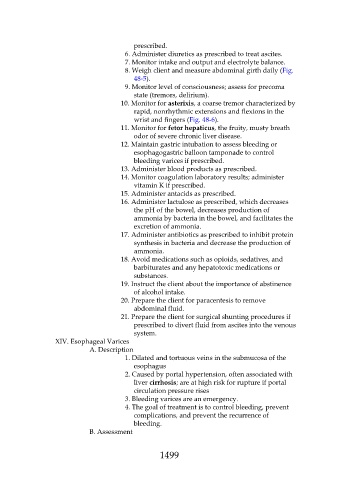Page 1499 - Saunders Comprehensive Review For NCLEX-RN
P. 1499
prescribed.
6. Administer diuretics as prescribed to treat ascites.
7. Monitor intake and output and electrolyte balance.
8. Weigh client and measure abdominal girth daily (Fig.
48-5).
9. Monitor level of consciousness; assess for precoma
state (tremors, delirium).
10. Monitor for asterixis, a coarse tremor characterized by
rapid, nonrhythmic extensions and flexions in the
wrist and fingers (Fig. 48-6).
11. Monitor for fetor hepaticus, the fruity, musty breath
odor of severe chronic liver disease.
12. Maintain gastric intubation to assess bleeding or
esophagogastric balloon tamponade to control
bleeding varices if prescribed.
13. Administer blood products as prescribed.
14. Monitor coagulation laboratory results; administer
vitamin K if prescribed.
15. Administer antacids as prescribed.
16. Administer lactulose as prescribed, which decreases
the pH of the bowel, decreases production of
ammonia by bacteria in the bowel, and facilitates the
excretion of ammonia.
17. Administer antibiotics as prescribed to inhibit protein
synthesis in bacteria and decrease the production of
ammonia.
18. Avoid medications such as opioids, sedatives, and
barbiturates and any hepatotoxic medications or
substances.
19. Instruct the client about the importance of abstinence
of alcohol intake.
20. Prepare the client for paracentesis to remove
abdominal fluid.
21. Prepare the client for surgical shunting procedures if
prescribed to divert fluid from ascites into the venous
system.
XIV. Esophageal Varices
A. Description
1. Dilated and tortuous veins in the submucosa of the
esophagus
2. Caused by portal hypertension, often associated with
liver cirrhosis; are at high risk for rupture if portal
circulation pressure rises
3. Bleeding varices are an emergency.
4. The goal of treatment is to control bleeding, prevent
complications, and prevent the recurrence of
bleeding.
B. Assessment
1499

